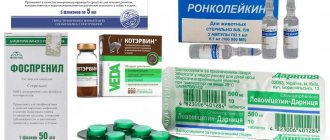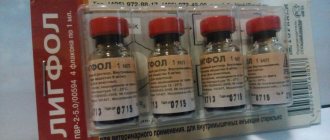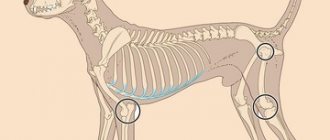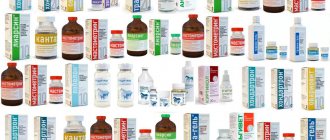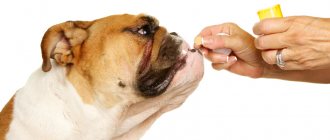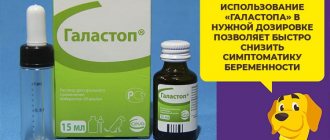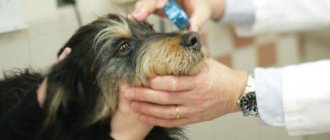How to use Alben C
The description of the drug Alben S for cats is contained in the instructions along with the rules for its use:
- The dose is calculated individually: 5 kg of cat weight – 1 tablet. If the cat weighs less than 2.5 kg, one tablet is crushed, dissolved in 10 ml of water in the form of a suspension, shaken and immediately administered to the pet: 0.5 kg of the cat’s weight - 1 ml of suspension.
- Administration: oral in crushed or whole form, single dose.
- Time of use: in the morning during feeding.
- Before use, a starvation diet is not prescribed and laxatives are not given.
The suspension is injected into the animal's mouth using a syringe without a needle. If the drug is given to a large cat, Alben C is not brought to a suspension state, but mixed with food.
How to use
According to the instructions for use, Alben C tablets are given to dogs once, regardless of whether they are used for preventive or therapeutic purposes. Since the active components affect mature parasites and their larvae, one dose is enough for your pet to get rid of helminths.
The drug can be given in two ways:
- Forcibly.
The procedure is unpleasant for animals, but effective. The tablet should be placed only on the root of the tongue so that the pet cannot spit it out. To simplify this procedure, it is worth purchasing a tablet dispenser at the pharmacy. Especially if you have a large dog. - With food.
Mix the crushed tablet with a small amount of food. To feed the medicine, it is better to choose your pet’s favorite treats. Canned food, ready-made spiders, and minced meat are good for these purposes. Some owners hide the tablets in a piece of meat or sausage.
The anthelmintic should be given in the morning. It is advisable to give the medicine half an hour before feeding, but there is no need to follow a special diet the day before, or to rinse the intestines.
According to the instructions, the dosage of Alben S for dogs is calculated simply - 1 tablet per 5 kg of weight. To calculate the exact dose for puppies weighing less than 2.5 kg, follow these steps:
- Crush one tablet as finely as possible.
- Add 10 ml of water to the resulting powder.
- Mix thoroughly to obtain a homogeneous suspension.
- Draw the required amount of medicine into a syringe without a needle, calculating 1 ml of the resulting suspension per 0.5 kg of weight.
- Give the puppy a drink from the syringe.
If you use this algorithm of action, you will be able to prevent an overdose. Dividing a tablet into several equal parts (more than two) is very difficult.
If for some reason you use Alben, created for farm animals, to deworm dogs, then the dosage is calculated differently - 1 tablet per 7 kg of weight. When using a suspension, 1 ml of liquid will be needed per 5 kg of pet weight, but it is better to buy a drug intended for dogs.
Note! For preventive purposes, the animal should be given the drug every quarter.
Reviews from dog owners
Ivan, Rostov. I try to give my dogs anthelmintic on time, once every 3 months. But... I have 3 dogs, if you do everything according to the rules, it doesn’t come cheap. I started looking for affordable and effective remedies and came across these pills.
Many dog owners prefer Alben S, as it is effective and has a low cost.
It turned out that they work well! The dogs are small (Pekingese), for three I buy 2 packs. There is no need to dissolve, I just put the medicine on each person’s tongue. I've been using it for a year now, everything is fine. I won’t change it, everything suits me.
Zhanna, Moscow. I picked up a teenage puppy on the street and, of course, had to be treated. Fleas, and worms, where would we be without them? I chose Alben S, it was recommended at the pharmacy. At first I couldn’t get used to the pills, but then I simply crushed them, filled them with water and gave them a syringe. It’s simple, the dog didn’t even have time to get upset. After treatment, I vomited dead worms, since then there seem to be no problems. I will be deworming again soon for prevention.
Valentina, Samara. I generally trust this company, I have already bought several drugs, I have no complaints. I have been using the tablets for 3 years, you can say that my golden retriever dog has grown up on them. I like that there are no side effects, the dog does not spit out the drug, I give it with food. In general, the medicine works and is affordable. I'm not going to replace it with something else.
Side effects and contraindications
An anthelmintic drug, if the recommended therapeutic dose is followed, does not provoke complications or side symptoms. Allergic rashes, disturbances in the functioning of the digestive tract (diarrhea, vomiting, loss of appetite, refusal to feed), drowsiness, depression, a slight increase in temperature are noted only in the case of hypersensitivity of the animal’s body to the active components of the drug.
As a rule, side symptoms develop on the first day after oral administration of Alben. If the animal's condition worsens, we recommend consulting with a veterinarian.
Alben is strictly not allowed to be used during pregnancy, especially in the early stages, as well as in lactating females. If the animal's body is hypersensitive to active substances, appropriate therapy is carried out aimed at eliminating side symptoms, and another effective medicine is prescribed to treat helminthic infestations.
The anthelmintic drug is not used for acute fascioliasis, emaciated, severely weakened animals or birds suffering from viral-bacterial diseases.
After taking Alben, slaughter of agricultural animals and poultry for meat is allowed 13–15 days after therapeutic, scheduled deworming. Poultry eggs can be consumed on the fifth day after treatment. During forced slaughter, meat is used to produce meat and bone meal and animal feed.
special instructions
Before using the product, it is recommended to conduct a test: feed the drug to a flock of 50-100 chickens and monitor their condition for 3 days. If no health problems are detected, the rest of the flock can be dewormed. Albendazole penetrates into chicken meat and eggs, so after the deworming procedure, birds should not be slaughtered for meat for 1 week, and eggs should not be consumed for 4 days. If for some reason the chicken was slaughtered, its meat can be boiled and fed to the animals.
Find out how to remove worms from chickens.
Eggs laid during this period can also be used as food for animals, after boiling them. Since albendazole is characterized by a low degree of toxicity, people should not eat, drink, or smoke while working with it. You should wear gloves, and after completing the procedure, wash your hands thoroughly with soap.
"Alben" for chickens against worms: dosage, instructions for use
When breeding chickens, parasites can become a serious obstacle to success, in particular worms, which poison birds and literally suck out nutrients
One of the effective methods of combating worms is the Alben remedy, but in order to achieve a positive result, it is important to know how to use it correctly. This is what we will talk about today
Composition, release form, packaging
The drug "Alben" (Albendazole, Tabulettae Albenum) is granules or tablets weighing 1.8 g for oral administration.
One tablet (granule) of the drug consists of:
- albendazole (0.36 g);
- lactose filler (0.93 g);
- starch (0.4 g);
- calcium stearate (0.08 g);
- polyvinylpyrrolidone (0.03 g).
The tablets are marketed packaged in blister packs made of paper covered with foil - 25 tablets each. Blister packs are packed in cardboard boxes; 1 such box can contain 25, 100 or 200 tablets. The granules are packaged in jars made of opaque polymer, which are tightly closed with a lid - 25, 100, 200 or 500 pieces each.
Pharmacological properties
"Alben" is an anthelmintic drug that has a universal range of effects, covering cestodes, nematodes and trematodes that live in the gastrointestinal tract, lungs, liver, and bile ducts of chickens.
Albendazole is characterized by rapid absorption; it leads to a deterioration in carbohydrate metabolism and the cytoplasmic microtubular system of intestinal canal cells in worms, due to which glucose transport is inhibited, cell division is suppressed, oviposition and the development of worm larvae are disrupted, and paralysis develops.
Dead parasites are excreted from the body of chickens in feces. Due to the fact that the product is effective in combating parasitic larvae, the bird's walking area is simultaneously disinfected. The product belongs to the 4th hazard class of substances according to GOST 12.1.007-76, that is, it is not dangerous for animals within the prescribed dosage.
Indications for use
"Alben" is effective against cestodes, nematodes and trematodes, it is used in the treatment of:
- amidostomosis;
- capillariasis;
- syngamosa;
- ascariasis;
- cestodosis;
- coccidiosis;
- histomoniasis (enterohepatitis);
- heterokidosis;
- prostagonymosis.
How to give to chickens: method of application and dosage
The Albena dosage for chickens is 1 tablet per 35 kg or ½ granule per 10 kg of bird weight. The product is ground into powder, mixed with food, placed in feeders and the bird is allowed to eat freely. It is better to carry out the procedure in the morning. The next day it must be repeated.
Important! Treatment with the drug does not lead to the need to restrict chickens’ access to food and use laxatives. It is best to mix “Alben” with food, since when putting medicine dissolved in water into drinkers, it will not be possible to control how much water each bird drank or whether it drank at all
The drug dissolved in water can be given to each chicken individually, taking into account its weight - using a syringe from which the needle has previously been removed, pour a little into the open beak. However, this is a rather labor-intensive process.
special instructions
Before using the product, it is recommended to conduct a test: feed the drug to a flock of 50-100 chickens and monitor their condition for 3 days. If no health problems are detected, the rest of the flock can be dewormed.
Albendazole penetrates into chicken meat and eggs, so after the deworming procedure, birds should not be slaughtered for meat for 1 week, and eggs should not be consumed for 4 days.
If for some reason the chicken was slaughtered, its meat can be boiled and fed to the animals.
Find out how to remove worms from chickens. Eggs laid during this period can also be used as food for animals, after boiling them.
Since albendazole is characterized by a low degree of toxicity, people should not eat, drink, or smoke while working with it.
You should wear gloves, and after completing the procedure, wash your hands thoroughly with soap.
Contraindications and side effects
If the recommendations for the amount and method of taking the medicine were followed, no side effects were found.
Indications for use
The medicine for dogs is used for the following pathologies:
- ascariasis;
- echinococcosis;
- dipylidia;
- uncinarium;
- coenurosis;
- hookworm;
- toxocariasis;
- mesocestoidosis;
- other helminthic infestations caused by roundworms and tapeworms.
The drug can be used for medicinal purposes, regardless of the degree of infection or stage of development of the disease. Also, an anthelmintic can be used to prevent infection by endoparasites, which can “settle” in the intestines, liver, lungs, heart and other organs.
The medicine is suitable for deworming before vaccination, as well as before mating. Worming before vaccinations or mating must be carried out, since parasites can have a negative impact on overall health. In addition, with the breakdown of their waste products, intoxication of the body occurs.
Indications and contraindications
Before using Alben tablets for animals, you need to study the instructions. This is necessary so that negative reactions do not develop.
The drug is indicated for the following conditions
:
- toxocariasis;
- nematodirosis;
- hemonchosis;
- uncinariasis;
- heterokiosis;
- dictyocaulosis;
- moniesiosis;
- habertiosis;
- dictyocaulosis;
- mulleriosis;
- Cystocaulosis;
- metastrongylosis;
- fascioliasis;
- paramphistomatosis;
- toxascariasis.
The drug is contraindicated
:
- for use in emaciated animals;
- for infectious pathology;
- at the beginning of pregnancy;
- during the mating season for fur-bearing animals, pigs, goats, sheep.
Description of the veterinary drug
Alben tablets (Tabulettae Albenum) are a universal, effective complex anthelmintic of a new generation for animals. The nonproprietary international name is albendazole. The drug belongs to the anthelmintic drugs of the benzimidazole group. Intended for oral use only.
The anthelmintic agent is packaged in 25 tablets weighing 1.8 g, which are packaged in aluminum blisters, cardboard boxes, and polymer jars with lids. There can be one or four blisters in a cardboard box. Jars contain 25, 50, 100, 200 tablets. Alben is also available in the form of granules, packaged in plastic jars with lids.
The anthelmintic drug in one tablet contains 0.36 g (20%) of albendazole and auxiliary ingredients: polyvinylpyrrolidone, calcium stearate, potato starch, lactose. Does not contain genetically modified products.
Alben against worms is prescribed to birds (chickens, ducks, turkeys, broiler chickens), rabbits, pigs, cats, dogs, and other farm and domestic animals. Used in veterinary medicine for therapeutic and prophylactic purposes.
The anthelmintic belongs to the category of moderately dangerous veterinary drugs. Not toxic to warm-blooded animals. However, before use, we strongly recommend that you consult with a veterinarian and carefully read the instructions for the pharmacological product, which indicates the frequency of administration and dosage for a specific type of animal.
According to the instructions, Alben must be stored in dry, cool, dark places at a temperature of 0–23 ° C in its original packaging. Shelf life from the date of release is two years.
Alben in tablets in recommended dosages does not have a teratogenic, sensitizing, or hepatogenic effect. Well tolerated by the body of warm-blooded animals. In rare cases, it provokes side symptoms, complications, disruptions in the functioning of internal organs and systems.
Composition and properties
The main active component of Albena is albendazole with a 20% concentration . In addition, there are various excipients. The medicine is available in tablets and granules. The weight of one tablet is 1.8 g. Moreover, the active ingredients in one tablet are 360 mg.
Alben belongs to the group of anthelmintics with a wide range of activities. The drug is active against not only sexually mature, but also immature parasites. This applies mainly to cestodes and nematodes. It also effectively fights trematas that have already reached sexual maturity. The medicine has an ovicidal effect. The effect of the medication is that it disrupts the process of carbohydrate metabolism and interferes with the microtubular functions of helminths. This leads to their death, and then quickly elimination from the dog’s body.
The product is administered orally, so it quickly dissolves in the digestive tract and penetrates into most tissues of the pet’s internal organs and systems. Subsequently, it is excreted from the animal’s body along with feces and urine, both unchanged and in the form of metabolites.
Alben tablets are prescribed for deworming an animal. By the way, the drug is used not only to treat dogs, but also goats, pigs, sheep, horses, cattle, birds and others. Indications for use of Alben are the following:
- Nematodosis in the gastrointestinal tract . This applies to habertiosis, ostertagiosis, nematodirosis. The medicine is also used for ascariasis, toxascariasis, toxocariasis, uncinarosis and hookworm. Other indications for the use of the drug are bunostomosis, hemonozol, habertiosis, strongyloidiasis, esophagostomosis, etc.
- Nematodosis in the lungs . This applies to diseases such as metastrongylosis, mulleriosis, and dictyocaulosis. The medicine is also used for protostrogylosis, cystocaulosis and neostrogylosis.
- Cestodosis . The medicine is actively used for avitellinosis, moniesiosis and tizanissiosis.
- Trematodosis . Alben is prescribed for paramphistomatosis, dicroceliosis, fascioliasis.
In all these cases, Alben helps to cure the dog. The medicine is also used to prevent all these parasitic diseases.
Release form
The tablet form of the drug "Alben" is suitable for domestic cats and dogs. The instructions for use (in veterinary medicine) do not recommend using the tablets for preventive purposes. One anthelmintic tablet contains 0.36 g of albendazole. If necessary, it can be divided into several parts. One package contains 25, 50 or 100 tablets. They are packaged in blisters of 25 pcs. The cost of the drug (100 tablets) is 320-340 rubles.
In the form of granules (granulated powder), the drug is packaged in jars of 1000 g or bags of 500 g. The cost of a large package is 1200-1270 rubles.
Pharmacological properties
“Alben” tablets contain 360 mg of albendazole as an active ingredient in 1 tablet, and as excipients: polyvinylpyrrolidone, calcium stearate, potato starch and lactose.
"Alben" granules in 1 g contain albendazole - 200 mg as an active ingredient, and as excipients: polyvinylpyrrolidone, calcium stearate, potato starch and lactose.
Albendazole, which is part of the drug, has a wide spectrum of anthelmintic action, is effective against mono- and polyinfestations, is active against sexually mature and immature nematodes and cestodes, as well as sexually mature trematodes. Possessing an ovicidal effect, it reduces the infestation of pastures with helminth eggs.
Albendazole, which is the main component of the drug, perfectly resists both mature and immature cestodes, nematodes and trematodes.
The mechanism of action of the drug is quite simple:
- disrupts carbohydrate metabolism and microtubular function of parasites,
- The parasites die and are eliminated from the body naturally.
First, let’s look at the key characteristics of the drug “Alben”, its composition and release form.
“Alben” in granules is placed in multilayer paper bags, polymer jars or buckets, with a volume of 0.05, 0.5 and 1 kg, respectively. “Alben” tablets are packaged in cardboard containers or in polymer containers (25 and 100 pieces each). 1 Alben tablet contains: albendazole - 0.25 g and praziquantel - 0.025 g, as well as secondary elements.
In 1 g of Alben granules you can find: albendazole - 0.2 g, as well as secondary elements.
The active ingredient in the drug is albendazole, which suppresses the activity and destroys most types of worms.
The drug also contains auxiliary components: calcium stearate, polyvinylpyrrolidone, potato or corn starch and lactose.
Alben tablets are available in plastic jars of 25 and 100 pieces. Tablets for cats and dogs are not recommended for prophylactic purposes. If necessary, the tablet can be divided into several parts.
The active substance albendazole is a potent substance and has a detrimental effect on adult helminths and their larvae. This makes it possible to cleanse your pet’s body of worms and their waste products in a short time.
When using the drug, you should be aware that it does not have an active effect on all types of helminths. This drug affects the nervous system of the helminth.
As a result, the parasite’s carbohydrate metabolism is disrupted and biochemical processes in its body are inhibited. This results in paralysis of the worm's muscles and its elimination from the pet's intestines.
How to choose a dose
The drug is intended for oral use. Tablets are given to animals forcibly, and granules are mixed with food. The dosage is calculated depending on weight. The use of Albena in the amount of 1 tablet per 50 kg of weight is indicated for the treatment of worms in cows and bulls. The dose is increased (up to 1 tablet per 35 kg) in case of paramphistomatosis, dicroceliosis. In granules - 3.75 or 5 g for every 100 kg.
Goats (domestic) and sheep are given 1 tablet per 70 kg of weight. In powder form, the dosage is 2.5 g (3.75 g in severe cases) per 100 kg. To treat helminthic infestation in pigs, you need to take one Albena tablet for every 35 kg. If granulate is used, the dosage (per 100 kg) is 5 g.
Fur-bearing animals are given 2.5 g of anthelmintic drug per 10 kg. In tablets – 1 pc. by 7 kg. For 10 kg of poultry weight, 0.5 g of granulate should be used. Frequency of application – 1 time per day for 2 days.
If treatment is indicated for a large number of animals, a dose of the medicine is added to the feed per 1 animal. You can consume milk and eggs after anthelmintic therapy only after two weeks.
Instructions for use
Dosage of tablets by weight
The exact dosage and duration of treatment is prescribed by the veterinarian. In accordance with the instructions, the recommended dose is 1 tablet per 7 kg of animal body weight. If you use a medicine intended specifically for dogs, Alben C, then the dosage is calculated differently - 1 tablet per 5 kg of dog weight.
The anthelmintic agent is intended for single use. The tablet should be given in the morning while feeding the pet.
Prevention is recommended to be carried out once every 3 months. The prophylactic dose is equal to the therapeutic dose.
How to give?
Owners often have difficulty giving medication to their pet. You can do this in 2 ways:
- Forcibly . The tablet should be placed on the root of the tongue so that the dog cannot spit it out. But if the dog is large, then it is better to give the medicine using an introducer (pill dispenser). This is a special device that can be purchased at veterinary pharmacies. Its device resembles a syringe.
- At the time of feeding with food . The tablet should be crushed and mixed with food. If natural food is used, then the medicine can easily be hidden in a piece of meat.
Other types
Alben C is a type of drug enhanced by another active ingredient, praziquantel. Thanks to this component, the worms stop absorbing glucose and gradually die. They leave the body along with feces.
Alben, produced in the form of granules , is indicated for farm animals. It is not recommended for use in treating dogs.
Alben is also available in suspension form and is called Alben Forte . This remedy is used to treat farm animals. It is not recommended to give it to dogs.
Analogs
Alben has a number of analogues, which are also prescribed as anthelmintic agents. These include:
- Alvet. A broad-spectrum anthelmintic drug that actively acts against the adults and larvae of nematodes, trematodes, and cestode adults. The main active ingredient is albendazole. In addition, it contains vitamin E and lactose. The drug is given to the bird in the morning, mixed with feed. The ratio is 0.5 g per 10 kg of bird weight.
- Biofermin. Has a broad spectrum anthelmintic effect. It is used for ascaridiosis, heterokidosis, capillariasis, syngamosis, rayetinosis. The active substance is flubendazole (5%). The drug is given to birds for 7 days with food at the rate of 60 g per 100 kg of food.
- Piperazine. An effective anthelmintic drug, the main active ingredient of which is piperazine adipate. Has a toxic effect on helminths. For 1 kg of bird weight, 2.5 g of the substance is given. The course of treatment is 2 days.
- Promectin. An antiparasitic agent whose active substance is ivermectin. Used for the treatment and prevention of internal and external parasites. Effective in the fight against all roundworms, acaroses, entomoses, lice, nematodes. The norms and doses of the drug are prescribed by the doctor.
- Tetramizole. Water-soluble anthelmintic. Its active substance is tetramizole chloride. It has a wide spectrum of action, is active in the lungs and digestive organs. Used once during morning feeding of birds.
- Fenbazen. Another anthelmintic whose active ingredient is fenbendazole. It has a detrimental effect on nematodes and some cestodes. Used with feed at the rate of 0.0045 g per 1 kg of bird weight for 4 days.
- Febtal. The active ingredient is 5-phenyl-thio-2-benzimidazole carbamate. Active against nematodes and cestodes. The drug is given to chickens in groups, mixed with feed at the rate of 1 crushed tablet per 15 kg of weight or 1 g of granules per 22 kg of weight.
- Fenbendazole. A broad-spectrum drug that is active against Giardia, nematodes, cestodes and some trematodes. It is characterized by low toxicity. Use the product for group treatment, mixing it with morning feed at the rate of 7.5 mg per 1 kg of weight.
Alben is one of the most common anthelmintic drugs, which not only fights the disease itself, but is also an excellent preventative drug. Effective against cestodes and nematodes, and also copes well with adult trematodes.
Treatment of worms in pigs: how to remove helminths?
Modern veterinary medicine offers farmers a lot of tableted anthelmintic drugs and potent drugs in the form of solutions. Treatment and prevention of helminthiasis in piglets is carried out using the following means:
- Brovadazole kills most known worms and their larvae. When used, it does not cause side effects. A person can consume meat products after treating a pig 72 hours later;
- Levamisole is a popular broad-spectrum antihelminthic drug. Effective against nematodes parasitizing the lungs and intestines. Veterinarians recommend repeating the procedure 60 days after deworming;
- Ivermectin is a drug for single use in the form of injections. Effective for ascariasis, strongyloidiasis, stephanurosis, sarcoptic mange, esophagostomosis;
- Dectomax is a broad-spectrum medicine for helminths in piglets. Used for the treatment and prevention of helminthic infestations.
Fighting worms in pigs with folk remedies
Natural anthelmintics are a good alternative to strong worm medications. Pigs tolerate treatment with tablets and injections well, but supporters of a healthy lifestyle reluctantly resort to the use of strong chemicals. How to treat a pig for worms using folk remedies? Here are a few time-tested natural remedies, namely:
- Garlic is a well-known anthelmintic. Essential oils in the onion destroy worms and larvae. Garlic creates unfavorable conditions in the stomach and intestines for the life and reproduction of helminths.
- Bitters herbs are a group of herbs used for worms. These include tansy, yarrow, and wormwood. All of them have an anthelmintic effect, but the benefits of their use will not be immediately noticeable. Only through systematic use can one expect good results. The grass is first crushed and added to pig feed in dry form. Effective as infusions. Bitters have a specific taste. Often animals may refuse to accept them.
When using traditional medicine recipes when treating piglets, it is important not to forget that they are most effective for prevention. When symptoms appear and the simplest herbs multiply, it will not be enough to treat animals
Larvae in advanced stages live not only in the intestinal lumen, but parasitize in a number of other organs - the liver, bile duct and bladder, and lungs. Natural remedies in this case will be ineffective.
Every farmer should know this: The pig’s hind legs have failed: what does this mean?
Worms in pigs: symptoms, treatment, video
Every farmer should know the symptoms, treatment and prevention of worms in pigs. Piglets often suffer from helminths. Experienced livestock breeders prevent infection of individuals. If you regularly include garlic and bitter herbs in the diet of piglets, the pigs will not have worms. How do you control worms in pigs on the farm?
ratings, average:
out of 5)
Instructions for use in veterinary medicine
Veterinarians prescribe the anthelmintic drug Alben tablets to animals for the prevention and treatment of helminthic infestations caused by various types of intestinal parasitic worms. When carrying out preventive deworming, veterinarians take into account the data of the epizootological situation in the regions.
For rabbits, fur-bearing animals, pigs, birds, cats, dogs, the medicine is prescribed for:
- gastrointestinal nematodes (bunostomiasis, esophagostomiasis, nematodiosis, osteragiasis, hemonchiosis, habertiosis, cooperiosis);
- cestoses (monesiosis, tysanissiosis, avitellinosis);
- trematodes (dicroceliosis, paramphistomatosis);
- toxoscariasis;
- pulmonary helminthiasis (dictyocaulosis, cystocaulosis, metastrongylosis, neostrongylosis, muleriosis, cystocauliosis);
- mixed helminthic infestations.
For poultry, an anthelmintic is used in the treatment of ascariasis and heterokiosis. Fur-bearing animals are treated with Alben for the following worms: uncinariasis, toxoscarosis, hookworm.
The dosage of the anthelmintic agent is calculated based on the body weight of the animals:
- For cattle, the main dose is 1 tablet. by 49 kg of weight. For the treatment of ostertagiasis, dicroceliosis, fascioliasis, paramphistomatosis, we give 1 table. based on 34 kg.
- For goats and sheep, 1 tablet is required. by 70 kg.
- For horses - 1 table. by 50 kg.
- For piglet, pigs - 1 table. by 30–34 kg.
- For poultry - 1 table. per 35–40 kg of bird weight (10 mg/kg).
- For fur animals - 1 table. by 7–25 kg of weight. Alben for rabbits and other fur-bearing animals is given 1 tablet. two days in a row.
During group deworming, having previously calculated the dosage, the anthelmintic is mixed with concentrated feed or mixed feed. Dose of Alben per feed per head:
- for horses, cattle - 0.5–1.0 kg;
- for sheep, goats, pigs - 160–200 g;
- for birds - 45–50 g;
- for fur animals - 50–105 g.
When treating helminthic infestations, Alben tablets are forcibly placed on the root of the tongue of animals. For more convenient use, you can pre-grind the anthelmintic into powder, mix it and give it to animals with mixed feed, your cat’s or dog’s favorite treats, or mix it into drinking water and inject it into your pets using a disposable syringe without a needle or using a syringe-introducer, which can be purchased at a veterinary pharmacy. pet stores.
The finished medicinal mixture is poured into feeders for a group of 10–100 animals
At the same time, it is important to ensure a free approach to them. Before carrying out mass deworming, experts recommend that each batch of veterinary medication be first tested on a small group of animals.
If there are no complications, no side symptoms in the first 2-3 days after administration, you can begin processing the entire livestock.
Indications for use.
For deworming of large and small ruminants with the following diseases:
- trematodes (acute and chronic fascioliasis, dicroceliosis, paramphistomiasis);
- nematodes of the gastrointestinal tract (haemonchiasis, bunostomiasis, esophagostomiasis, nematodirosis, ostertagiasis, habertiosis, cooperiosis, strongyloidiasis, trichostrongylosis, trichocephalosis, neoascariasis);
- nematodes of the lungs (dictyocaulosis, protostrongylosis, mulleriosis, cystocaulosis);
- cestodoses (moniesiosis, avitellinosis, tyzaniesiosis).
For deworming of pigs with ascariasis, esophagostomiasis, metastrongylosis, trichuriasis, strongyloidiasis and fascioliasis.
For deworming poultry:
- trematodoses (echinostomatidosis of ducks and geese);
- nematodes (ascaridiosis, heteracidosis, capillariasis, amidostomiasis, ganguleteracidosis of geese and ducks)
- cestodiasis (hymenolepidosis of geese and ducks, drepanidoteniasis of geese).
Dosage of veterinary drug
The dose of this drug depends on the type of animal and its disease.
Cattle - as a basic dose, one tablet per 49 kg or 3.7 g of granules per 99 kg. For dicroceliosis, fasciolosis, winter ostertagiasis and paramphistomatosis - 4.9 g per 99 kg or one tablet per 34 kg.
- Goats and sheep - as a basic dose, 2.4 g of granules per 99 kg or one tablet per 69 kg. For dicroceliosis, fascioliasis and protostrongyloidiasis - 3.7 g per 99 kg or one tablet per 44 kg.
- Pigs – 4.9 g granules per 99 kg or one tablet per 34 kg.
- Horses, mules and donkeys - 3.7g granules per 99kg or one tablet per 49kg.
- Poultry (for ascariasis, heterokiosis) - 0.45 g of granules per 9 kg (once a day for two days in a row) or one tablet per 34 kg (once a day for two days in a row).
- Fur-bearing animals (for toxocariasis, hookworm, toxascariasis, uncinariasis) - 2.45 g of granules per 9 kg or one tablet per 6 kg.
It should also be noted that “Alben S” for cats and dogs can be found on sale. It is used once in a dosage of 1 tablet per 5 kg of animal weight. The drug is taken in the morning with a small amount of food (if necessary, administered forcibly).
Doses and order of application.
For ruminants, the drug is administered orally, once individually in the following doses:
- for nematodes of the gastrointestinal tract (haemonchiasis, bunostomosis, esophagostomiasis, nematodirosis, habertiosis, cooperiosis, strongyloidiasis, trichostrongylosis, trichocephalosis, neoascariasis), nematodes of the lungs (dictyocaulosis, mulleriosis, cystocaulosis) and cestodoses (moniesiosis, avitellinosis, tis aniesiosis) in a dose of 1 ml per 5 kg of animal weight;
- for trematodes (fascioliasis, dicroceliosis, eurythremosis and paramphistomiasis), as well as for ostertagiasis and protostrongylosis - 1.25 ml per 5 kg of animal weight.
For pigs with nematodes (ascariasis, esophagostomiasis, metastrongylosis, trichocephalosis, strongyloidiasis) and fascioliasis, the drug is administered orally once individually at a dose of 1.0 ml per 5 kg of animal weight.
For geese, ducks and chickens with nematodes (ganguleteracidosis, ascaridiosis, heteracidosis), trematodes (echinostomatidiasis, prostagonymosis) and cestodiasis (drepanidoteniosis, hymenolepiasis, rayetinosis), the drug is used in a dose of 1 ml per 5 kg of bird weight for two days in a row individually or in a group way (not more than 100 heads) with food in the morning feeding. The drug in a calculated dose is mixed with feed at the rate of 50 g of feed per bird.
Composition and action
The main feature of the antiparasitic agent is its wide spectrum of action. The drug is capable of destroying round and tapeworms, and the stage of their development does not matter. The effectiveness is due to the combination of two active components - albendazole and praziquantel. Also contains potato starch and lactose. These components perform a purely auxiliary function.
The principle of action of the combination of active ingredients is based on the disruption of metabolic processes in parasites. In addition, under the influence of praziquantel and albendazole, the permeability of cell membranes in helminths increases, which inevitably leads to their death.
The active components are well absorbed into the bloodstream, but their concentration in the intestines remains quite high. Thanks to this, the drug is effectively used to destroy not only intestinal worms, but also worms that parasitize the lungs and other organs. The components are excreted from the animal’s body for the most part along with feces and urine.
Methods and methods for treating pigs
Worms in pigs can manifest themselves in different types with their own symptoms; accordingly, treatment should be selected taking into account the specific parasite. Today there are two ways to combat worms in farm animals:
- With the use of drug therapy;
- Folk remedies.
The first one is the most effective, so they most often resort to it.
Medicines to combat worms
To treat pigs, veterinarians usually prescribe anthelmintic drugs that have a wide spectrum of action, such as:
- Albendazole
- Fenbendazole
- Febantel
- Levamisole.
Most of them contain several active substances and have a detrimental effect on both adult worms and larvae.
Depending on the age of the sick piglet, the type of drugs and their dosage are determined
In case of mild disease in pigs and an accurately established diagnosis, narrow-spectrum drugs can be used:
- Nitroquinyl
- Closantel.
Only a veterinarian can accurately diagnose and prescribe therapy. Therefore, when the first signs of worms appear in piglets and pigs, you should not treat them yourself, but should immediately contact a specialist. And prevention from worms will help to avoid infection.
Folk remedies in the fight against helminthiasis in pigs
People have been keeping this type of farm animal for a very long time. Just like today, in those days people had to deal with the infection of piglets with worms and look for ways to remove them. This is how folk remedies appeared, one of the most popular of which is garlic. The anthelmintic properties of this plant have been known since ancient times, and it fights parasites equally effectively in both humans and domestic animals. For pigs, finely chopped garlic is added to their feed at the rate of 1 gram per kilogram of animal weight.
Tansy is added to the food of pigs, and a teaspoon per piglet weighing up to 30 kg is added to the food of piglets.
The second place in effectiveness and popularity belongs to the plant - tansy. Its flowers are added to the feed of piglets, one teaspoon per piglet weighing up to 30 kg.
But when choosing folk remedies, it is necessary to take into account that worms affect various organs and many of them are resistant to herbal preparations. Therefore, treatment must be prescribed by a veterinarian.
What can be given to piglets with helminthic infestation?
The choice of therapy depends on the age of the animal. The most commonly used drugs in the treatment of piglets are:
- hygrovetin;
- nilverm;
- sodium fluoride in powder.
Of these, only Nilverm is administered subcutaneously, the rest are added to the feed. But each drug has certain limitations. So sodium fluoride should not be given to piglets that are fed pig milk, as well as to adult pregnant females in the last month.
Hygrovetin is approved for use in young animals over two months old. It is given by mixing it with food for a month for babies and 70 days for adult animals.
Nilverm can be used both for sucklings and large pigs, changing the dosage accordingly.
Important tips: Treatment and prevention of pigs against worms
Pharmacology
The main active substance of this product is albendazole; it has a detrimental effect on both sexually mature individuals and the larvae of various parasites.
The principle of action of the medicine is very simple:
- Negatively affects the microtubular function of worms and disrupts normal carbohydrate metabolism.
- Dead worms are removed naturally.
The medicine is well absorbed from the gastrointestinal tract and quickly disperses throughout the body. The product is easily tolerated by animals and is considered non-hazardous.
Characteristics of the medicine
It is a broad-spectrum antiparasitic drug. It is produced in the form of granules in containers of different sizes and tablets. This is a Russian-made drug.
The advantages of Alben are high efficiency, one-time use, destruction of various types of parasites, and ease of use.
All this is ensured by the composition of the drug. The main active ingredient in it is albendazole. One tablet contains 0.36 g of the main substance, and one gram of granules contains 0.2 g. The drug also contains excipients.
Albendazole has a wide spectrum of antiparasitic action. It is effective against polyinfestations. The substance destroys nematode larvae, trematodes, cestode eggs, and has ovicidal properties. The drug reduces the infestation of the territory with helminth eggs during its treatment.
How does the medicine work? Albendazole selectively inhibits beta-tubulin polymerization, disrupts glucose transport in the bodies of parasites, and reduces the activity of the microtubular system of their cells. The main active ingredient of the drug, thus, leads to paralysis and then to the death of helminths.
Indications for the use of the drug are gastrointestinal nematodes, including ascariasis, toxocariasis, trichuriasis, uncinariasis, ganguleterakiosis.
The drug is used in the fight against pulmonary nematodes, trematodes and cestodes.
Contraindications and side effects
The drug has a certain degree of toxicity, so it cannot be used to remove parasites from animals during the first half of pregnancy, or for kittens and puppies up to three months. It is also prohibited for the treatment of helminths in emaciated animals suffering from infectious diseases. As for side effects, the instructions inform about their absence if the medicine is used correctly.
Contraindications and side effects of Albena for dogs
If the dosage is observed, the drug is well tolerated and does not harm the dog’s liver or immune system. It should not be given to puppies under 3 weeks of age, whelping or lactating females. If lethargy, vomiting, diarrhea or constipation occurs, you should seek veterinary help.
Alben is a medication widely used in veterinary practice to combat helminths.
The medicine has a gentle effect, so it is often recommended for prophylactic purposes .
Treatment of worms in laying hens Alben or Tetramizole
Both drugs have a pronounced anthelmintic effect. They differ in the active substance, but in both cases they can be used to treat helminthiasis in laying hens.
Tetramizole is available in powder form, which makes mixing the medicine with water a little easier.
However, Alben can be crushed independently by mixing with water or food. In terms of toxicity, they are approximately the same, so they have no visible advantages over each other.
As for Alben, there is one important clarification. Its use is not recommended if laying hens are kept in enterprises or farms, i.e.
eggs are intended for further sale. As for personal consumption, eggs can be eaten after four days from the date of taking the drug. After taking Tetramizole you will also have to wait four days.
Contraindications for use
Alben is a fairly toxic substance, so it should be used with caution. There is also a list of certain contraindications to taking this drug:
- if the bird is sick with any disease, or is severely emaciated;
- should not be given to individuals suffering from infectious diseases.
In addition, the use of Alben affects the composition of animal milk, eggs and meat. That is why, after deworming, at least two weeks must pass if slaughter is planned. For chickens, pigs and horses, this period is slightly shorter - only seven days. As for the eggs, more than four days should pass.
special instructions
When using Alben S, personal hygiene and instructions for working with medicines for animals are strictly observed. It is allowed to slaughter small cattle and cattle for meat after 336 hours, and poultry, pigs and horses after 170 hours from the last use of the drug.
Before the expiration of the specified period, the meat of animals that were forced to be killed can be used as food for fur-bearing animals only with the permission of a veterinarian.
It is prohibited to use milk from dairy animals for food purposes for 96 hours after using Alben S.
Milk that was received ahead of schedule can be used as animal feed after heat treatment.
Recommendations and special instructions
When using Alben, you should take into account the following recommendations:
On large farms, it is not necessary to deworm all chickens at once. It is better to select 50 birds from the population and give the drug only to them. Next you need to monitor their condition for 3-4 days.
If everything goes well, this procedure can be carried out with the rest of the birds. When working with Alben, precautions must be taken, since it has a moderate degree of toxicity. When in contact with the medicine, do not eat food, drink water or smoke.
The work must be carried out with rubber gloves. After the procedure, hands should be washed using detergent. In order for the birds to eat all the food with the medicine, they need to be underfed in the evening, and more tasty ingredients must be added to the mash with Alben. This could be, for example, boiled potatoes and carrots. It is important that the birds eat all the food in one go. Simultaneously with deworming, the chicken coop should be cleaned using antiseptics. In this case, you will need to carefully remove the droppings in the chicken coop for 1 week and much more often than was done before.
